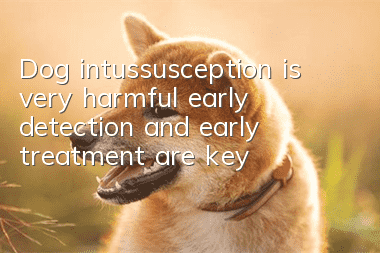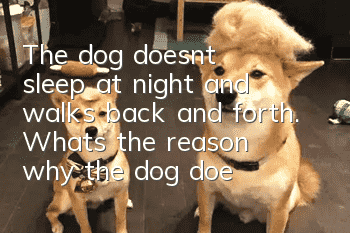Dog intussusception is very harmful, early detection and early treatment are key!

In clinical canine disease, canine digestive tract diseases account for a large proportion, among which canine intussusception is relatively common, with the highest incidence rate in puppies (2 to 5 months old), accounting for more than 80%. Clinically, it is mainly seen in the anterior segment of the intestine being invaginated into the posterior segment of the intestine, and invagination of the jejunum and ileum into the colon is most common. This disease develops rapidly, and the mortality rate is very high if not treated in time. Therefore, the principle of diagnosis and treatment of this disease is early detection, early diagnosis and treatment to avoid serious sequelae or death due to delay. To this end, I will discuss the diagnosis and treatment of canine intussusception. Below I will discuss canine intussusception from the aspects of clinical symptoms, abdominal palpation and X-ray fluoroscopy. Research shows that post-operative care and fighting infection are important.
1. Introduction: Intussusception refers to an abdominal pain disease in which a section of intestinal tube and the mesentery are invaginated into the adjacent intestinal tube, causing local blood circulation disorder, congestion and necrosis. In clinical canine disease, canine digestive tract diseases account for a large proportion, among which canine intussusception is relatively common, with the highest incidence rate in puppies (2 to 5 months old), accounting for more than 80%. Clinically, it is mainly seen in the anterior segment of the intestine being invaginated into the posterior segment of the intestine, and invagination of the jejunum and ileum into the colon is most common. When the intestinal tube is invaginated, the mesentery is often invaded at the same time, thus causing blood supply disorders. If time passes, it often leads to local necrosis or perforation. The concave intestinal segment will also compress the blood vessels, causing venous blood and lymph fluid to accumulate. The intestinal wall swells and even the intestinal mucosa ruptures causing bleeding. However, the grassroots often fails to correctly diagnose canine intussusception, which often delays the condition and even causes the death of the sick dog. To this end, the author discussed the diagnosis and treatment of canine intussusception.
2. Causes of canine intussusception
2.1. Seasonal changes and environmental changes
Canine intussusception is clinically more common in the spring and summer seasons and in early winter. Litter division and transfer of puppies are also one of the important factors. Because of seasonal changes, sudden changes in climate, high and low temperatures, environmental changes and other stresses, puppies' resistance can easily decrease and diseases may occur.
2.2. Secondary to certain infectious diseases
Clinically, intussusception secondary to canine distemper, canine parvovirus, canine coronavirus and other bacterial infections is not uncommon. Although the real cause of intussusception is still unclear, it may be closely related to the above-mentioned viral and bacterial infections, that is, uncoordinated intestinal peristalsis and contraction caused by pathogenic infection or other unknown reasons, resulting in proximal intestinal tube Invading into the distal intestine causing intussusception.
2.3. Parasitic infection
The proportion of intestinal parasitic infections in dogs is very high, which is particularly harmful to puppies. When parasites deprive the host of nutrition, they cause physical obstruction and damage to the host's intestinal tract, and at the same time excrete metabolic toxins, etc., causing intestinal peristalsis disorder in dogs, causing strong peristalsis and reverse peristalsis in a certain section of the intestine, or varying degrees of intensity, and extremely It is easy for one section of the intestine to slip into another section, forming intussusception.
2.4. Factors such as feeding and management
Reasonable and scientific feeding and management are the basis for raising good animals. In addition to planned immunization and reasonable deworming for dogs, reasonable and scientific diet, exercise, and hygiene are also very important. For example, overeating, unscientific bathing when the ambient temperature is too high or too low, and dog walking in bad weather should be avoided.
3. Clinical symptoms
The disease often occurs suddenly, with abdominal pain, vomiting, blood in the stool and lumps in the abdomen as the main symptoms. The closer the intussusception site is to the anterior segment of the sick dog, the more severe the vomiting and related symptoms will be, and the faster the course of the disease will progress. Dogs generally suffer from abdominal pain, arched back, food refusal and vomiting, dehydration and weight loss. Affected dogs suffer from sudden vomiting and abdominal distension, and often pass a small amount of bloody stool. If intussusception occurs in the front part of the small intestine, there is usually a small amount of black stool. If intussusception occurs in the back part of the small intestine, the stool will usually be a small amount of dark red, and the affected dog will appear restless. , moaning, chirping. It can be divided into three levels according to the level of intestinal intussusception: first-level intussusception is the invagination of the jejunum into the jejunum or ileum. The ileum is invaginating into the cecum; secondary intussusception is when the jejunum is invaginating into the jejunum and then into the ileum; third-level intussusception is when the jejunum is invaginating into the cecum, then into the ileum, and then into the cecum.
4. Diagnosis
4.1. Consultation
The main purpose is to understand the specific conditions of feeding and management, the time of onset, and the main symptoms.
4.2. Palpation
The abdomen is sensitive during palpation. A sausage-like mass can be felt in the abdominal cavity, which is mobile, and the intestines feel thick and solid. At this time, attention should be paid to distinguishing it from foreign bodies in the intestines, swelling of the pancreas, and a large number of parasites in the kidneys and intestines. If you do a rectal examination, you will see blood in the stool.
4.3. X-ray diagnosis
Taking X-rays after a barium meal is helpful in diagnosing the disease.
X-ray manifestations: low small intestinal obstruction, sometimes intestinal-shaped mass and intussusception of the distal colon and pneumotheca signs can be seen in the right abdomen or upper abdomen. Barium enema can reveal a cup-shaped or round filling defect at the obstructed end of the insertion part and a spring-like shadow of the sheath. If necessary, laparotomy can be performed to confirm the diagnosis.
B-ultrasound diagnosis
Typical concentric circle echo images in the abdominal cavity. The cross-sectional image of intussusception is the same concentric circles with low echo and strong echo. This is the "ring sign" and "bull sign" caused by the invagination of the strong echo sheath and the low echo invagination part. Eye signs”.
5. Treatment
5.1. Conservative treatment
For dogs diagnosed early, the intussusception is relatively short and can be easily reduced externally during enema. The specific method is: use warm soapy water for enema or warm saline solution to about 38°C, and add a certain amount of anisodamine and antibiotics. Apply lubricant to a human catheter and perform a deep enema. The solution is slowly infused according to the infusion method, and the sick dog is in a position of lower front and higher back. While performing the enema, massage the sick dog's abdomen, and finallyUse your fingers to gently squeeze the intussusception area. After reset, gavage 0.5 to 1.0 g of activated charcoal. 6 to 8 hours later, observe whether black feces is discharged. If there is, it proves that the intestines are unobstructed.
5.2. Surgical therapy
For those who are discovered late, have a long course of disease (more than 2 days), and have severe clinical symptoms, surgical treatment is required. In addition, if enema reduction fails, surgical treatment must be taken immediately. Severely ill dogs should be rehydrated before surgery to strengthen the heart, correct acid-base poisoning, adjust electrolyte balance, antibacterial and anti-inflammatory, supplement nutrition, etc. Blood transfusions should be performed when necessary. Before surgery, France's Vicosol 0.1 mg/kg body weight was injected subcutaneously for general anesthesia. The sick dog was placed in a supine position, and a wide range of hair was shaved and disinfected from the bottom of the abdomen from the umbilicus to the pubic bone, and infiltration anesthesia with procaine was used around the set incision. Make an incision of 5 to 20 cm into the abdominal cavity along the linea alba (the opening should be as small as possible depending on the size of the dog) to expose the abdominal cavity. Pull the diseased intestine out of the incision, and use a large gauze soaked in warm saline to isolate the abdominal wall incision and protect the intestine. When the intussusceptive bowel is viable, try to reduce it manually, that is, the surgeon uses the thumb, index finger, and middle finger to push the distal end of the intussusception evenly and gently downward, and the assistant cooperates with the proximal end to gently pull it out. Do not pull or squeeze violently to avoid intestinal rupture. When there is too much intrusion and plastic surgery is ineffective, surgical scissors can be used to cut the outer layer of intestine to reset it. If there is no necrosis in the inserted intestinal tube or the intestinal wall and intestinal lumen lesions are not serious, the intestinal wall can be sutured, and the intestinal tube can be closed with a layer of nodule suture method. If the intussusception site has adhesions and surgery cannot reduce the intussusception or if it is found that the intestinal tube has become severely necrotic after reduction, the adhesions or necrotic parts need to be removed. After the intestinal tube is resected, the incision is disinfected and trimmed, and then the intestinal stumps are anastomotic. Because the intestinal tube of dogs is relatively thin, one layer of nodule suture is often used instead of the traditional two-layer suture. After the suturing is completed, inject physiological saline into the intestinal cavity to check the suturing effect. In order to promote intestinal healing and prevent intestinal fluid leakage, a part of the greater omentum can be covered at the intestinal anastomosis and fixed on the intestinal wall. Rinse the intestine with warm saline, apply anti-inflammatory drugs, then return the intestine, and suture the incision as usual. The stitches were removed after 7 days and the incision healed.
5.3. Postoperative care
Dogs with intussusception are prone to recurrence after surgery. Therefore, postoperative care is important. Infusions are generally given for 3 to 6 days after surgery, mainly for antibacterial and anti-inflammatory purposes, replenishing body fluids and nutrients, adjusting electrolyte balance, correcting acid-base poisoning, and strengthening the heart. Sick dogs will feel discomfort at the surgical site after surgery, so care must be taken to prevent the surgical site from being bitten and affecting healing. After the operation, feeding and management should be strengthened, and the patient should fast for more than 48 hours, and then gradually provide easy-to-digest liquid foods such as milk and gravy. It is forbidden to drink cold water or eat iced feed, give bones, meat, and food with a lot of oil and water, and prevent the dog from doing strenuous exercise. Antibiotics should be used for 7 days after surgery to prevent postoperative infection.
6. Conclusion
According to clinical observations, intussusception is prone to occur in puppies between 2 and 5 months old. Mostly due to vomiting and enteritiscaused. Clinically, the cure rate for dogs with simple intussusception in the early and middle stages is relatively high, while the cure rate for late-stage critical cases and cases with severe intestinal necrosis requiring end-to-end anastomosis is low. In particular, the cure rate for secondary intussusception from infectious diseases such as canine distemper, canine parvovirus, and canine coronavirus is even lower. If intussusception is diagnosed, surgical treatment should be performed as soon as possible to prevent the occurrence of multiple intussusception or intestinal necrosis. The general cure rate for patients with severe dehydration and low body temperature is very low. In some cases, secondary intussusception may occur after surgery. In this case, the cure rate is almost zero. After surgery, you should give some easily digestible food and clean and sufficient drinking water. Because the digestive function has not fully recovered after surgery, the dog feels hungry after surgery. Don't let it eat too much at one time. Excessive food can cause food retention in the narrowed part of the intestinal tract. If vomiting occurs again, treatment will fail. After intestinal anastomosis, it is best to inject 1 vial of gentamicin diluted with 20 ml of warm saline (same body temperature) into the intestinal tube. Local anti-inflammation in the intestine can play a role
Recommended Good Things
Aineng Pet Odor Eliminating Disinfectant can effectively remove body odor/feces odor and other odor molecules! Effective in treating skin diseases caused by fungi/bacteria! Can kill parvovirus/canine distemper virus/coronavirusetc!
It is edible grade for pets, does not contain fragrances, does not contain chemicals, can be sprayed directly, and is harmless to human pets!
Consultation: 13028809308 (WeChat synchronization)
Scan the QR code on WeChat to enter the purchase
- Dog’s anal gland odor, please note that this is a sign of your dog’s health!
- How to make your dog like to eat dog food Four ways to make your dog fall in love with dog food
- How to protect your dog’s food? Teach you tips on training your dog
- Why do dogs defecate everywhere? How can dogs stop defecating everywhere?
- What should I do if my dog has lupus? Immune system diseases should not be underestimated
- If your dog's hair is cut and the skin is cut, the flesh is exposed. If the dog's hair is accidentally cut and the skin is cut, it must be disinfected immediately.
- Do dogs need deworming in summer? What should you pay attention to when raising dogs in summer?
- What to do if your dog has indigestion? Dog indigestion is no small matter!
- What should you pay attention to when vaccinating your dog? What should you pay attention to when vaccinating your dog?
- Symptoms of Rheumatism in Dogs What conditions can cause rheumatism in dogs?



